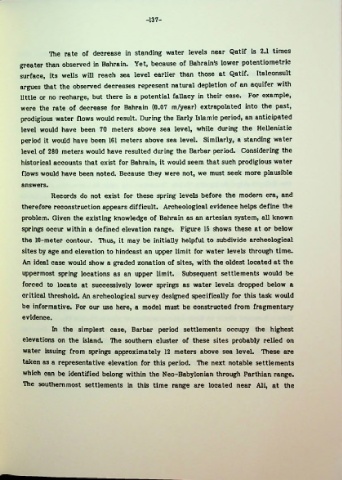Page 161 - Life & Land Use on the Bahrain Islands (Curtis E Larsen)
P. 161
-137-
Tlie rate of decrease in standing water levels near Qatif is 2.1 times
greater than observed in Bahrain. Yet, because of Bahrain’s lower potentiometric
surface, its wells will reach sea level earlier than those at Qatif. Italconsult
argues that the observed decreases represent natural depletion of an aquifer with
little or no recharge, but there is a potential fallacy in their case. For example,
were the rate of decrease for Bahrain (0.07 m/year) extrapolated into the past,
prodigious water flows would result. During the Early Islamic period, an anticipated
level would have been 70 meters above sea level, while during the Hellenistic
period it would have been 161 meters above sea level. Similarly, a standing water
level of 280 meters would have resulted during the Barbar period. Considering the
historical accounts that exist for Bahrain, it would seem that such prodigious water
flows would have been noted. Because they were not, we must seek more plausible
answers.
Records do not exist for these spring levels before the modern era, and
therefore reconstruction appears difficult. Archeological evidence helps define the
problem. Given the existing knowledge of Bahrain as an artesian system, all known
springs occur within a defined elevation range. Figure 15 shows these at or below
the 10-meter contour. Thus, it may be initially helpful to subdivide archeological
sites by age and elevation to hindcast an upper limit for water levels through time.
An ideal case would show a graded zonation of sites, with the oldest located at the
uppermost spring locations as an upper limit. Subsequent settlements would be
forced to locate at successively lower springs as water levels dropped below a
critical threshold. An archeological survey designed specifically for this task would
be informative. For our use here, a model must be constructed from fragmentary
evidence.
In the simplest case, Barbar period settlements occupy the highest
elevations on the island. Tlie southern cluster of these sites probably relied on
water issuing from springs approximately 12 meters above sea level. These are
taken as a representative elevation for this period. The next notable settlements
which can be identified belong within the Neo-Babylonian through Parthian range.
Tlie southernmost settlements in this time range are located near Ali, at the

